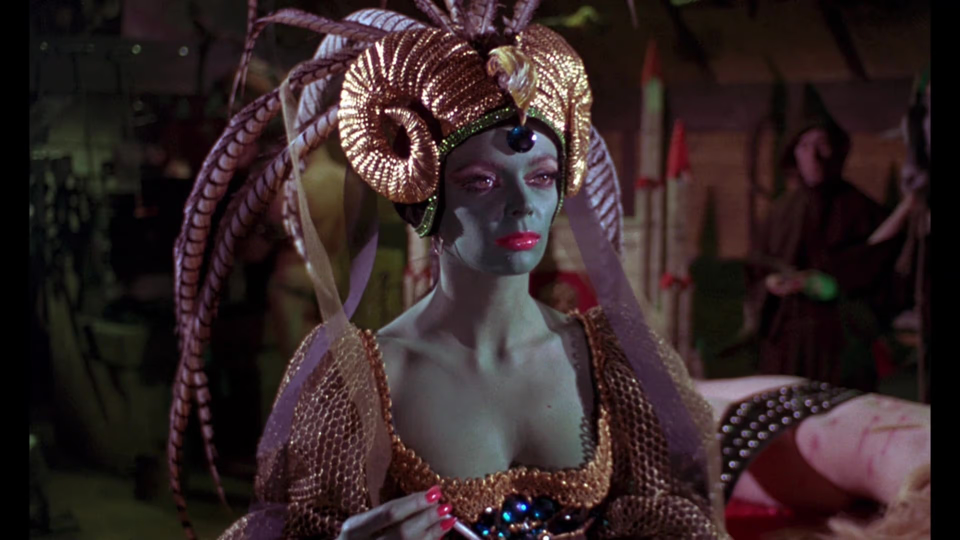The Crimson Cult

Curse of the Crimson Altar (The Crimson Cult here in the USA) has a good cast, but it is not a good film. This is evident from the opening scene.
A droning hum whines in and out as a young man named Peter Manning stands wearing a suit. He looks dazed. In front of him, a nude woman suffers a whip while lying strapped to a table. Men in black robes look on. One has a goat. Wearing a large headdress complete with ram horns, a green-skinned Barbra Steel introduces herself as Lavinia, the “Keeper of the Black Secret”1. She asks if Peter knows why he’s there. He does. She asks if he’s ready to sign. He is. A man brings over a large book and Peter signs his name. Then Lavinia hands Peter a dagger. Peter stabs the girl on the table. There’s a quick-cut to the goat, which seems distressed. Lavinia snaps her fingers. There’s a crack of thunder. A muscular man dressed in a leather bikini bottom, leather arm-bands, and a studded leather cap sprouting deer antlers brings over a branding iron which he presses into Peter’s chest.
Yes, that happens. The film packs a few more of these trippy, S&M-tinged sequences, but they exist more-or-less outside the main narrative.
The story concerns Peter’s brother, Robert, played by Mark Eden. When Peter doesn’t return home, Robert goes looking for him at his last known location, a remote country estate called Craxton Lodge. Robert’s arrival coincides with a local festival celebrating the burning of the witch Lavinia some three hundred years earlier. The estate’s owner, J.D. Morley, played by Christopher Lee, claims to have never heard of Peter, but invites Robert to stay on to continue his search. Robert agrees. Robert also meets another of the locals, Professor Marsh, played by Boris Karloff. Marsh, conveniently, is an expert on witchcraft.
As the film unwinds, the tone veers between cult conspiracy and Scooby-Doo mystery. Robert discovers secret doors and a fake spiderweb machine en-route to learning the truth behind his brother’s disappearance. But by the time the credits roll we’re left wondering if the scenes with Lavinia were meant to be real or imagined.
Sometimes ambiguity helps a film resonate. But in this case, it only serves to underscore the film’s patronizing approach to its horror elements. Consider the poor attempt at meta-humor. When one of the characters compares Craxton Lodge to “one of those old houses in horror films,” Robert replies, “It’s like Boris Karloff’s going to pop up at any moment.”
After my first viewing of The Curse of the Crimson Altar , I considered it something of a guilty pleasure. The over-the-top dream sequences and gratuitous nudity were good for a chuckle.
But watching it a second time, I found the film far less entertaining. Sure, Karloff is great. Even wheelchair-bound at eighty-years-old, he could still command a scene. But that’s about all this movie has going for it. Lee’s role gives him little to do, and Barbara Steele is wasted. The story’s mystery elements, already weak on the first viewing, border on tedious the second time around.
Given that this was one of Karloff’s final films, it’s probably required viewing for any serious fan of classic horror. Just don’t watch it a second time.
Notes
-
For the record, there is no Crimson Altar or Crimson Cult. ↩︎